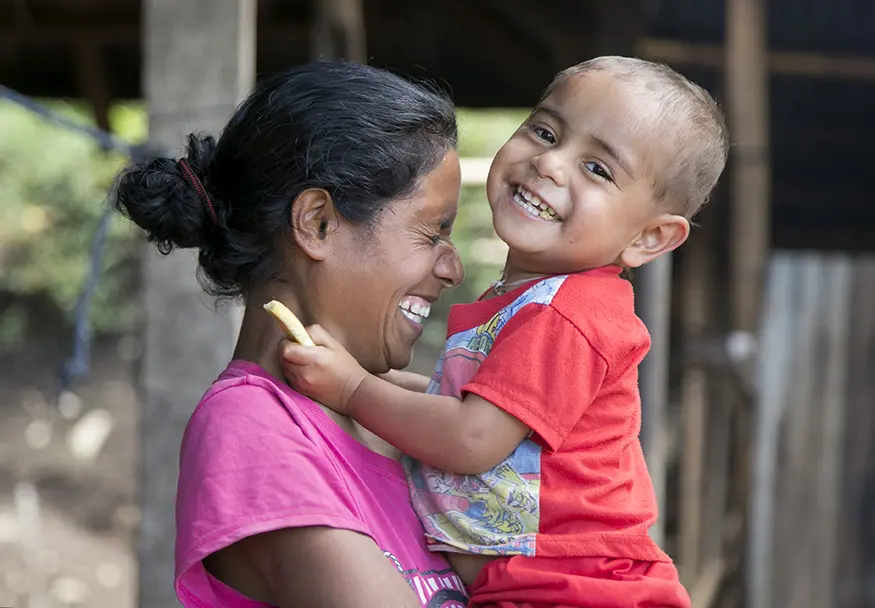By Michele Learner
As Bread for the World has long emphasized, the “1,000 Days” period from pregnancy to age 2 is the most important window for human nutrition. This unique, irreplaceable opportunity in every human life is therefore a top priority in our efforts to end hunger and malnutrition.
Virtually all parents want to make sure their children have everything they need, especially food and especially very young children. But for far too many parents, conflict, climate change, economic crisis, marginalization, and other factors that lead to extreme poverty make it impossible to meet all their children’s needs. Whether their children grow up healthy, even whether they survive, is beyond their control. National governments and the global community have a responsibility to act so that young children don’t miss their best chance to survive and grow into healthy, productive adults.
Evidence that the human nutrition window is open for about 1,000 days, closing around the second birthday, had been building for years. Yet it was not until 2008 that there was broad consensus on this data and a global shift toward prioritizing this period.
The factors that determine whether a child celebrating her second birthday is well-nourished, ready to learn and explore her world, are not always obvious. We all know that human life is complicated. Although researchers can’t completely account for the outcomes for each child, they continue to collect and analyze information that will lead to better unerstanding. I’ll discuss the findings in a little more detail so we can assess what they mean for us as anti-hunger advocates.
Other recent blog posts from Bread for the World Institute include a Father’s Day reflection on children whose fathers are incarcerated, details on some of the financial returns of investments in the 1,000 Days in the United States, an update on what the international financial institutions that receive U.S. support are doing to help people devastated by the impacts of the global pandemic, and a note on our new one-pager resources, which explore how hunger, climate change, and racial equity issues are interconnected.
It is urgent to restore global health and nutrition services that have not been available up to this stage of the pandemic. We know that pregnant women, babies, and toddlers—people in the 1,000 Days—cannot fully recover from malnutrition or childhood illnesses as older children and adults usually do. Researchers continue to uncover more evidence that a healthy pregnancy is critical to preventing stunting, which, as Bread emphasizes, carries lifelong consequences for those who survive.
Research findings indicate that a significant amount of the risk that a child will be stunted at age 2 comes from conditions that are in place before he is born. Both babies who are born prematurely, and those who are small for their gestational age, face a more difficult start in life. This is because a baby’s weight and length at birth are important determinants of her health in early childhood.
When a group of scholars compared the importance of prenatal and postnatal factors in stunting, their analysis, published in the medical journal BMJ Open in 2019, found that while both weight and length at birth are important factors, other conditions also contribute to outcomes. Some of these are determined before pregnancy and continue to influence the child as she grows up (e.g., mother’s level of education), and some are intergenerational (e.g., mother’s height).
The analysis found that nutrition actions we may be more familiar with, such as exclusive breastfeeding, supplementing vital micronutrients such as iron and zinc, or vaccination against childhood diseases, are essential as well. These interventions save lives every day. Rather than downplaying their significance, the analysis emphasizes that nutrition for pregnant women and for all who may become pregnant in the future is also important. Nutrition during pregnancy is rightfully part of the 1,000 Days.
The authors of this analysis point out that everyone who is concerned about children’s survival and health, whether they’re global humanitarian workers, officials in ministries of health and agriculutre, nutritionists, doctors, community health workers, or parents of young children, should act urgently based on what we know now rather than waiting for more research.
Continued data collection and analysis are also necessary. Research priorities include pinpointing more specific risk factors for stunting among the many variables that affect people in the 1,000 Days, whether these influences are environmental, socioeconomic, biological, or something else.
Also notable for people in the 1,000 Days is recent reporting on the global shortage of midwives, which has worsened since the beginning of the pandemic. A report by the U.N. Population Fund included analysis published in The Lancet and looked at data on the midwife profession in 194 countries. It concluded that the pandemic led to “… the health needs of women and newborns being overshadowed, midwifery services being disrupted, and midwives being deployed to other health services.” The current estimate is that the world needs an additional 900,000 trained midwives, which is about one-third of the total workforce.
I was startled by both the impacts of the midwife shortage and the potential gains from filling this gap by providing midwives with the resources and training they need. If these needs are met, by 2035 two-thirds of maternal deaths, and nearly as many stillbirths and newborn deaths, could be prevented. This could save an estimated 4.3 million lives every year.
One root of both problems— the large number of malnourished pregnant women and the midwife shortage—is an age-old human problem: gender bias. A world that did not devalue women as compared to men would prioritize, simply as a matter of course, the food and nutrition needs of pregnant women. Persistent advocacy for gender equity might not be quite as critical to ending hunger.
But this is not the world we live in. Activists’ work to promote gender equity is more important than ever. We cannot end hunger without ensuring that pregnant women and others of reproductive age have essential life-sustaining nutrients–and to do that, women and men must be treated as equally valuable members of society. We should be sure to use a “gender equity lens” as we advocate to end hunger.
Michele Learner is managing editor with Bread for the World Institute.



